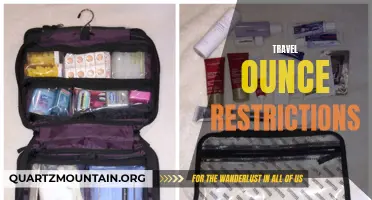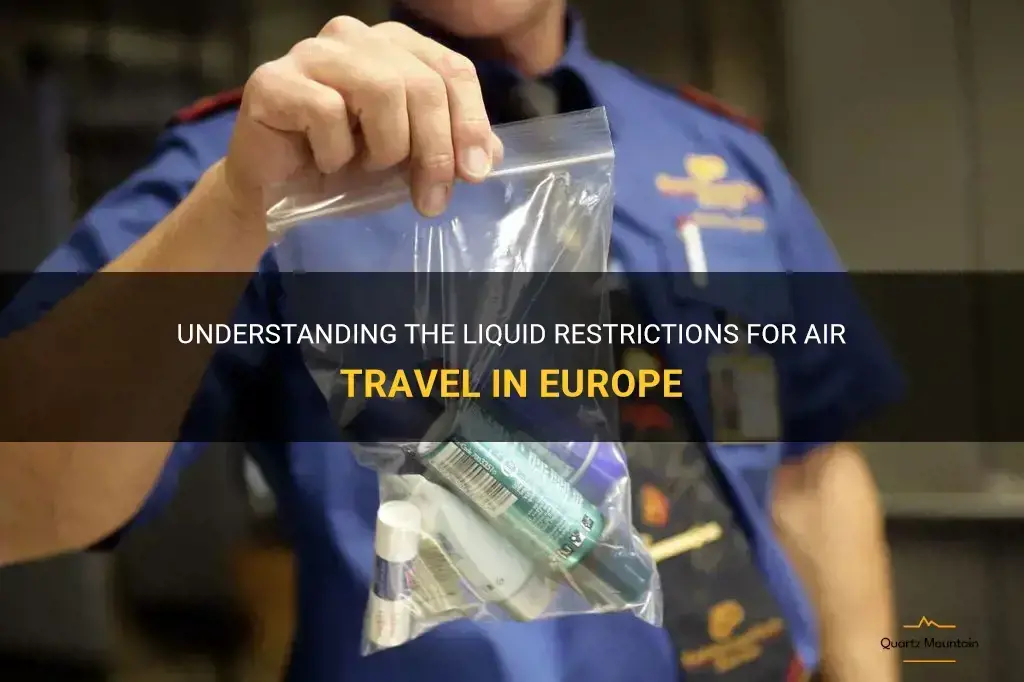
Air travel liquid restrictions in Europe have become a major consideration for travelers in recent years. As a result of the increased threat of terrorism, strict regulations have been implemented to ensure the safety of all passengers. These restrictions limit the amount of liquid that can be brought on board, creating a challenge for travelers who rely on certain toiletries or personal items. Understanding these restrictions and finding creative solutions has become essential for those looking to navigate the European skies.
| Characteristics | Values |
|---|---|
| Maximum volume per container | 100ml |
| Maximum total volume | 1 liter (1000ml) |
| Containers must fit in a clear, resealable plastic bag | Yes |
| Only one clear bag per person allowed | Yes |
| Liquids include gels, creams, pastes, and aerosols | Yes |
| Exceptions allowed for baby food and medications | Yes |
| Duty-free liquids purchased at the airport are allowed | Yes |
| Beverages and food purchased after security are allowed | Yes |
What You'll Learn
- What are the current liquid restrictions for air travel in Europe?
- Are there any exceptions to the liquid restrictions for certain types of passengers?
- Can passengers bring essential liquids, such as medications or baby formula, on board a flight in Europe?
- Are there any specific rules or regulations for carrying liquids in hand luggage on flights within Europe?
- How strictly are the liquid restrictions enforced at European airports?

What are the current liquid restrictions for air travel in Europe?
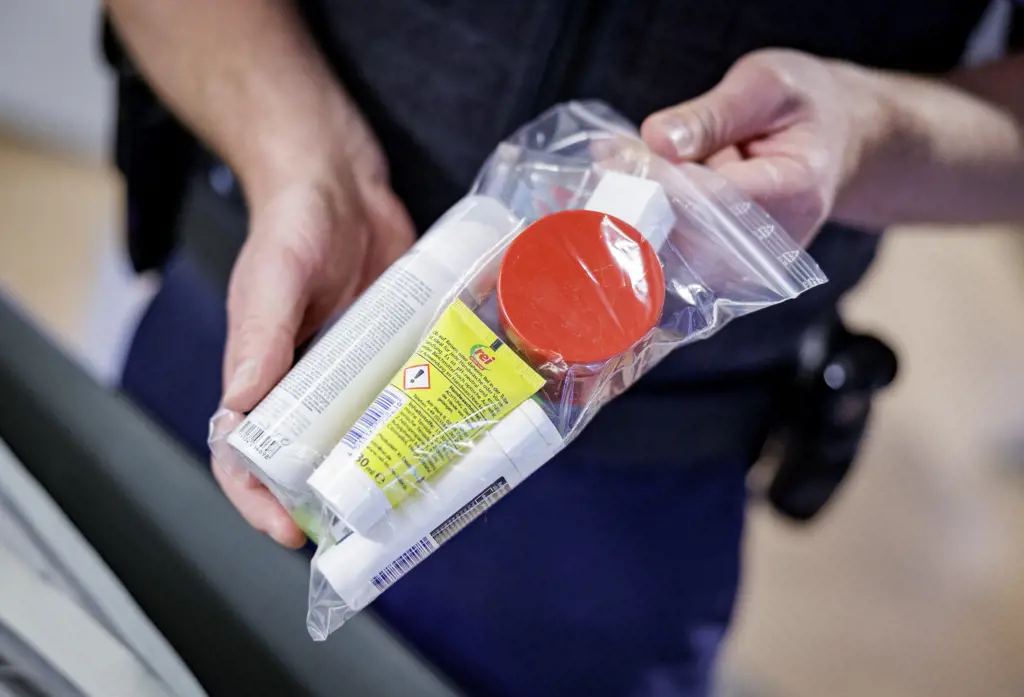
In recent years, air travel has become increasingly popular and convenient. However, with the rise in security threats, airports have implemented stricter rules and regulations to ensure passenger safety. One such regulation pertains to the amount of liquid passengers can carry in their hand luggage.
In Europe, the current liquid restrictions for air travel are in line with the regulations set by the International Civil Aviation Organization (ICAO). These restrictions were introduced in response to a thwarted terrorist attack in 2006, where liquid explosives were found to be the threat. The aim of these restrictions is to limit the amount of liquids that can be brought on board an aircraft to prevent the potential use of explosives.
According to the current European regulations, passengers are only allowed to carry liquids, aerosols, and gels in containers with a maximum capacity of 100 milliliters (3.4 ounces) each. These containers must be placed in a clear, resealable plastic bag with a maximum capacity of 1 liter (quart). Each passenger is limited to carrying one such bag.
It is important to note that these restrictions apply to all liquids, including but not limited to water, beverages, creams, lotions, perfumes, oils, and sprays. Additionally, these restrictions also apply to certain types of food items such as jams, honey, and other spreads. However, baby food and medications needed during the flight are exempt from these restrictions, provided they are for personal use and accompanied by appropriate proof such as a prescription or a baby's birth certificate.
It is worth mentioning that only one plastic bag per passenger is allowed, and it must be presented separately at the security checkpoint for screening. The contents of the bag must fit comfortably and the bag must be completely closed. Any liquids exceeding the maximum limit or not contained in a clear plastic bag will be confiscated by security personnel.
These liquid restrictions are enforced at all European airports, regardless of the airline or the country of origin. Passengers are advised to familiarize themselves with these regulations before their flight to avoid any inconvenience at security checkpoints. It is also recommended to pack any liquids that exceed the allowed limit in checked baggage to prevent confiscation.
In conclusion, the current liquid restrictions for air travel in Europe stipulate that passengers are only allowed to carry liquids in containers of 100 milliliters or less, placed in a clear plastic bag with a maximum capacity of 1 liter. These restrictions apply to all liquids and certain food items, but exemptions are made for baby food and medications. It is important for passengers to comply with these regulations to ensure a smooth and safe travel experience.
Navigating the Latest Emirates Travel Restrictions: What You Need to Know
You may want to see also

Are there any exceptions to the liquid restrictions for certain types of passengers?
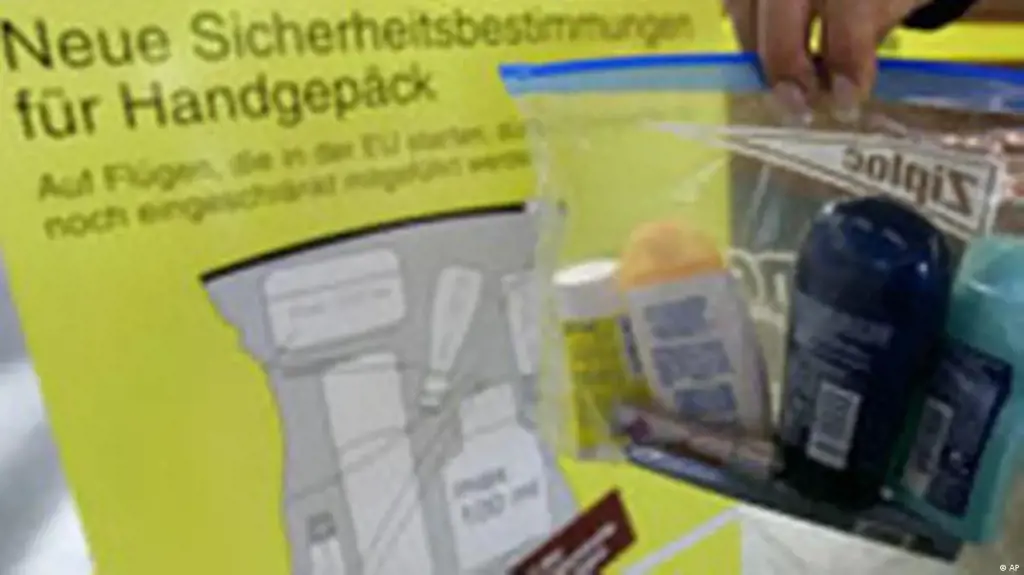
When it comes to air travel, there are restrictions on liquids that passengers can bring on board. This is done for security reasons, as these restrictions help to ensure the safety of all passengers onboard the aircraft. However, there are certain exceptions to these liquid restrictions for certain types of passengers.
The most common exception to the liquid restrictions is for passengers traveling with infants or young children. Parents or guardians are allowed to bring baby formula, breast milk, or juice for their infants or toddlers. These liquids are not subject to the usual limit of 3.4 ounces or 100 milliliters and can be carried in quantities necessary for the duration of the flight. However, these liquids may be subject to additional screening at the security checkpoint.
Passengers with medical conditions are also given exceptions to the liquid restrictions. They are allowed to bring any medically necessary liquids, such as prescription medications, liquid nutrition, or medical gels or creams. These liquids should be clearly labeled and presented to the security officer at the checkpoint for inspection. Passengers may be required to provide documentation, such as a doctor's note, to confirm their medical condition.
Another exception is for duty-free liquids. Passengers who have purchased duty-free liquids, such as alcohol or perfume, are allowed to bring them onboard the aircraft. However, these liquids should be packed in a secure, tamper-evident bag, and the receipt for the purchase should be visible. Passengers may be asked to present the receipt at the security checkpoint.
It's important to note that even with these exceptions, there are still rules and regulations that need to be followed. Passengers should always check with their airline or the Transportation Security Administration (TSA) for the most up-to-date information on liquid restrictions and any exceptions that may apply to their specific situation.
In conclusion, while there are strict liquid restrictions for air travel, there are certain exceptions for passengers traveling with infants or young children, passengers with medical conditions, and passengers carrying duty-free liquids. These exceptions are in place to accommodate the needs of these specific passengers while still maintaining the security of air travel. Passengers should always be aware of the rules and regulations regarding liquids and should check with the appropriate authorities before traveling with any liquids.
Understanding Qatar Airways' Travel Restrictions to India
You may want to see also

Can passengers bring essential liquids, such as medications or baby formula, on board a flight in Europe?
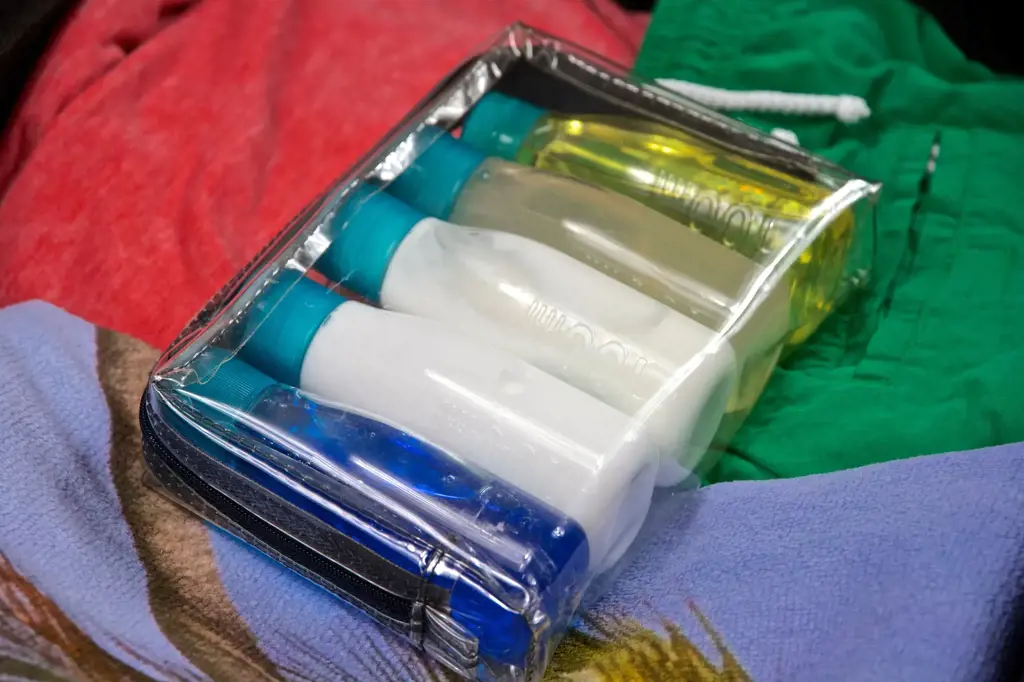
Passengers traveling within Europe are generally permitted to carry essential liquids, including medications and baby formula, on board their flights. However, there are certain rules and restrictions that must be followed to ensure compliance with airport security regulations.
Medications are considered essential liquids, and passengers are allowed to bring them on board without any quantity limitation. It is recommended to keep medications in their original packaging and carry a copy of the prescription, especially for controlled substances. If the medication needs to be refrigerated, passengers should inform the airline or security personnel in advance.
Baby formula and breast milk also fall under the category of essential liquids. Passengers traveling with infants are allowed to carry a reasonable amount of baby formula or breast milk that is necessary for the duration of the flight. These liquids are exempt from the usual restrictions on the transport of liquids, such as the 100ml limit in a clear plastic bag.
However, passengers traveling with baby formula or breast milk may need to undergo additional screening at the security checkpoint. It is advisable to inform the security staff in advance and be prepared for this possibility. It is also recommended to carry only what is needed for the flight to avoid any unnecessary hassle.
When carrying essential liquids on board a flight, it is important to remember that they need to be presented separately during the security screening process. This means that medications, baby formula, and any other liquids should be taken out of the carry-on bag and placed in a separate tray for X-ray screening. It is advisable to check with the specific airline and airport regarding any additional requirements they may have.
In cases where liquid medications or baby formula exceed the usual restrictions, passengers may need to request a special permission or obtain a medical certificate. It is recommended to contact the airline or airport well in advance to understand the necessary procedures and requirements for carrying such liquids.
In summary, passengers traveling within Europe are generally allowed to bring essential liquids, such as medications and baby formula, on board their flights. However, it is important to follow the specific rules and regulations set by the airport and airline. Carrying medications in their original packaging and carrying a copy of the prescription can help facilitate the process. Passengers traveling with baby formula or breast milk should be prepared for additional screening and should inform the security staff in advance. By being aware of the rules and guidelines, travelers can ensure a smooth and hassle-free journey.
Understanding Cathay Pacific's Travel Restrictions during the Pandemic
You may want to see also

Are there any specific rules or regulations for carrying liquids in hand luggage on flights within Europe?
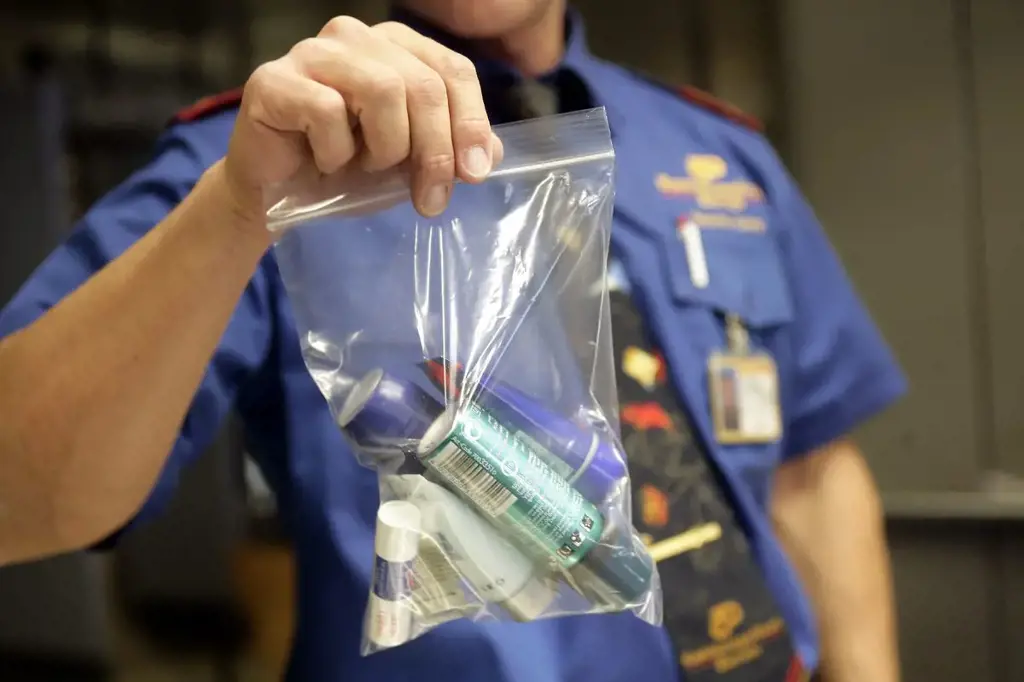
When it comes to air travel, there are specific rules and regulations that passengers must follow, especially when it comes to carrying liquids in hand luggage. These regulations ensure the safety of all passengers on board and help to maintain security during the flight. If you are traveling within Europe and plan to carry liquids in your hand luggage, it's crucial to be aware of these rules to avoid any inconvenience or confiscation of your belongings.
The rules for carrying liquids in hand luggage within Europe are called the "100ml rule" or the "3-1-1 rule." According to this rule, you are allowed to carry liquids in containers that have a maximum capacity of 100 milliliters (3.4 ounces) each. These containers must be placed in a clear, resealable plastic bag, with a maximum capacity of 1 liter (1 quart). Each passenger is allowed only one bag, and it must be presented separately for security screening.
This rule applies to all types of liquids, including water, beverages, gels, pastes, creams, lotions, oils, aerosols, and similar substances. However, some exceptions are made for essential medications, baby food, and special dietary requirements. These items may exceed the 100ml limit but may be subject to additional screening or documentation requirements. It's always advisable to carry the necessary documentation or prescriptions for such items to avoid any issues during security checks.
It is worth noting that the 100ml rule applies to each individual container. You cannot carry a larger container that is only partially filled with liquid, as it will still be subject to confiscation. If you have a larger container of liquid that you wish to take with you, it must be placed in your checked baggage. Remember to pack any medications or other essential items separately and in accordance with airline regulations.
Additionally, be cautious when traveling with duty-free liquids. If you purchased duty-free liquids from an airport shop, these may exceed the 100ml limit. However, they must be packed in a tamper-evident bag along with the receipt. These bags are provided by the airport or the shop at the time of purchase. The liquid must remain sealed in the bag until you reach your final destination. If you have a connecting flight, make sure to check the regulations at your transit airport regarding duty-free liquids.
It is essential to familiarize yourself with these rules and regulations before traveling within Europe. By following these guidelines, you will ensure a smoother security check process and avoid any potential delays or confiscation of your belongings. Remember to pack your liquids in a clear bag and place it separately for screening. Be mindful of the volume and container size, and always carry any necessary documentation or prescriptions for essential items. By adhering to these rules, you can have a hassle-free journey and enjoy your air travel experience.
Understanding Taiwan's Travel Restrictions to China: Everything You Need to Know
You may want to see also

How strictly are the liquid restrictions enforced at European airports?
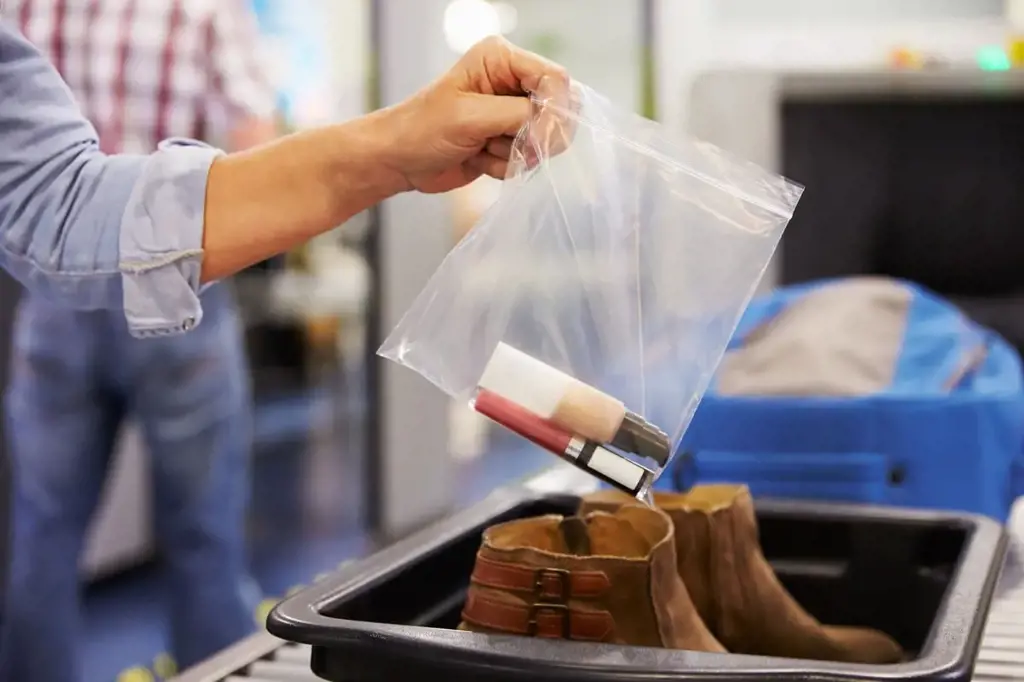
When traveling through European airports, it is important to be aware of the liquid restrictions in place. These restrictions are part of the security measures implemented to keep passengers safe while flying. In this article, we will discuss how strictly these liquid restrictions are enforced at European airports.
The European Union's liquid restrictions require passengers to adhere to the 100 ml maximum container size for liquids in carry-on baggage. All containers must also fit into a transparent, resealable plastic bag with a maximum capacity of one liter (or approximately one quart). These restrictions apply to all liquids, gels, and aerosols, including items such as water, shampoo, toothpaste, and cosmetics.
When it comes to enforcing these restrictions, European airports generally have strict security checks in place. Passengers are expected to show their liquids separately during the screening process. This means they must remove their plastic bag containing liquids from their carry-on luggage and place it in a separate tray for scanning. Security personnel will visually inspect the bag and may ask passengers to open it for further inspection.
Airport security personnel are well-trained in identifying potential security threats, and they have the authority to confiscate any liquid containers that do not meet the restrictions. Passengers who fail to comply with the liquid restrictions may also be subject to additional security measures, such as further questioning or more thorough personal searches.
While the enforcement of liquid restrictions varies slightly between different European airports, it is generally advisable to follow the rules strictly to avoid potential delays or confiscation of items. It is essential to pack all liquids in containers that comply with the size requirements and ensure they are placed in a transparent, resealable bag for easy inspection.
It is worth noting that some airports may have additional scanners, such as liquid scanning devices, which can determine if a liquid exceeds the allowed limit without the need for passengers to open their bags. These scanners use advanced technology to analyze the contents of liquid containers, making the process quicker and more efficient.
It is also important to remember that the liquid restrictions only apply to carry-on luggage. Passengers are free to pack larger quantities of liquids in their checked bags, as these undergo a separate screening process.
In conclusion, the liquid restrictions imposed by European airports are generally strictly enforced. Passengers are expected to adhere to the 100 ml container size and place all liquids in a transparent, resealable bag for easy inspection. Failure to comply with these restrictions can result in confiscated items and potential delays. By following the rules and being prepared, passengers can ensure a smooth and hassle-free journey through European airports.
Exploring the Grapevine: Current Travel Restrictions for Jamaica
You may want to see also
Frequently asked questions
In Europe, passengers are subject to the 100ml liquid restriction. This means that any liquids, gels, and pastes in carry-on luggage must be in containers that are 100ml or less. These containers must also fit into a clear, resealable plastic bag, with a maximum capacity of 1 liter.
Yes, there are some exemptions to the liquid restrictions in Europe. Prescription medications, essential medical supplies, and baby food or formula are allowed in larger quantities, as long as they are declared at the security checkpoint and may be subject to additional screening. Duty-free liquids purchased at the airport in a security tamper-evident bag are also allowed, as long as they were purchased on the day of travel.
If you have liquids that exceed the allowed limit in your carry-on luggage, they will be confiscated at the security checkpoint. It is important to pack any liquids that exceed the limit in your checked luggage to avoid this. In some cases, depending on the quantity and type of liquid, you may also be subject to additional screening or questioning by security personnel.





